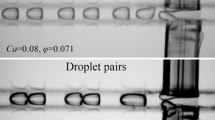Abstract
In this work, we report experimental and numerical studies of alternating and merged droplets in a double T-junction microchannel. The microchannel device is fabricated using PDMS substrate and experiments are performed with mineral oil with surfactant as the continuous phase and aqueous glycerol as the discrete phase. Based on the flow rate fraction ϕ and Capillary number Ca, four different flow regimes are identified: merging, stable alternating droplets, alternating droplets with transition and laminar. A numerical model that employs volume-of-fluid formulations is used to predict the alternating droplet generation process. In the stable alternating droplet regime, the effect of the discretephase flow rate ratio α on the droplet diameter ratio β is experimentally studied and compared with that predicted from the simulations. It is observed that the droplet diameter ratio β increases linearly with increase in the flow rate ratio α and a good match between experiments and simulations is observed. The diameters of droplets at different Capillary numbers Ca generated using single and double T-junction microchannels are compared and it is observed that, at low Ca, the double T-junction generates larger droplets as compared to single T-junction. In merged droplet regime, the effect of the continuous phase flow rate Q c and discrete phase viscosity μ d on diameter d m and interdistance between the droplets λ of the merged droplets are studied. It is observed that the merged droplet diameter d m is reduced and interdistance between the droplets λ increases with increase in the continuous phase flow rate Q c . As the viscosity of the discrete phase μ d increases, the diameter d m and interdistance between the droplets λ of the merged droplets decreases.
Similar content being viewed by others
References
Teh, S.Y., Lin, R., Hung, L.H. & Lee, A.P. Droplet microfluidics. Lab Chip 8, 198–220 (2008).
Schneider, T., Kreutz, J. & Chiu, D.T. The potential impact of droplet microfluidics in biology. Anal. Chem. 85, 3476–3482 (2013).
Hung, L.H. et al. Alternating droplet generation and controlled dynamic droplet fusion in microfluidic device for CdS nanoparticle synthesis. Lab Chip 6, 174–178 (2006).
Hung, L.H. & Lee, A.P. Microfluidic devices for the synthesis of nanoparticles and biomaterials. J. Med. Biol. Eng. 27, 1–6 (2007).
Sen, A.K., Darabi, J. & Knapp, D.R. Design, fabrication and test of a microfluidic nebulizer chip for desorption electrospray ionization mass spectrometry. Sens. Actuators B Chem. 137, 789–796 (2009).
Bhardwaj, P., Bagdi, P. & Sen, A.K. Microfluidic device based on a micro-hydrocyclone for particle-liquid separation. Lab Chip 11, 4012–4021 (2011).
Zheng, B., Tice, J.D. & Ismagilov, R.F. Formation of arrayed droplets of soft lithography and two-phase fluid flow, and application in protein crystallization. Adv. Mater. 16, 1365–1368 (2004).
Tice, J.D., Lyon, A.D. & Ismagilov, R.F. Effects of viscosity on droplet formation and mixing in microfluidic channels. Analytica Chimica Acta 507, 73–77 (2004).
Gupta, A. & Kumar, R. Effect of geometry on droplet formation in the squeezing regime in a microfluidic T-junction. Microfluid Nanofluid 8, 799–812 (2009).
Wehking, J.D., Gabany, M., Chew, L. & Kumar, R. Effects of viscosity, interfacial tension, and flow geometry on droplet formation in a microfluidic T-junction. Microfluid Nanofluid 16, 441–453 (2014).
Nunes, J.K., Tsai, S.S.H., Wan, J. & Stone, H. Dripping and jetting in microfluidic multiphase flows applied to particle and fiber synthesis. J. Phys. D: Appl. Phys. 46, 1–20 (2013).
Barbier, V., Willaime, H., Tabeling, P. & Jousse, F. Producing droplets in parallel microfluidic systems. Phys. Rev. E. 74, 1–4 (2006).
Hong, J., Choi, M., Edel, J.B. & DeMello, A.J. Passive self-synchronized two-droplet generation. Lab Chip 10, 2702–2709 (2010).
Song, H., Tice, J.D. & Ismagilov, R.F. A Microfluidic System for Controlling Reaction Networks in Time. Angew. Chem. Int. Ed. 42, 767–772 (2003).
Zheng, B., Tice, J.D. & Ismagilov, R.F. Formation of droplets of alternating composition in microfluidic channels and applications to indexing of concentrations in droplet-based assays. Anal. Chem. 76, 4977–4982 (2004).
Sajeesh, P., Doble, M. & Sen, A.K. Hydrodynamic resistance and mobility of deformable objects in microfluidic channels. Biomicrofluidics 8, 1–24 (2014).
Ward, T., Faivre, M., Abkarian, M. & Stone, H.A. Microfluidic flow focusing: Drop size and scaling in pressure versus flow rate driven pumping. Electrophoresis 26, 3716–3724 (2005).
Garstecki, P., Fuerstman, M.J., Stone, H.A. & Whitesides, G.M. Formation of droplets and bubbles in a microfluidic T-junction-scaling and mechanism of breakup. Lab Chip 6, 437–446 (2006).
Christopher, G.F., Noharuddin, N.N., Taylor, J.A. & Anna, S.L. Experimental observation of the squeezing-to-dripping transition in T-shaped microfluidic junctions. Phys. Rev. E 78, 1–12 (2008).
Li, X. et al. Study on the mechanism of droplet formation in T-junction microchannel. Chemical Engineering Science 69, 340–351 (2012).
Author information
Authors and Affiliations
Corresponding author
Rights and permissions
About this article
Cite this article
Surya, H.P.N., Parayil, S., Banerjee, U. et al. Alternating and merged droplets in a double T-junction microchannel. BioChip J 9, 16–26 (2015). https://doi.org/10.1007/s13206-014-9103-1
Received:
Accepted:
Published:
Issue Date:
DOI: https://doi.org/10.1007/s13206-014-9103-1




